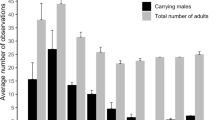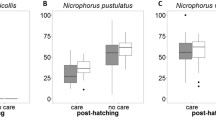Abstract
Facultative thermogenesis is often attributed to pythons in general despite limited comparative data available for the family. While all species within Pythonidae brood their eggs, only two species are known to produce heat to enhance embryonic thermal regulation. By contrast, a few python species have been reported to have insignificant thermogenic capabilities. To provide insight into potential phylogenetic, morphological, and ecological factors influencing thermogenic capability among pythons, we measured metabolic rates and clutch-environment temperature differentials at two environmental temperatures—python preferred brooding temperature (31.5 °C) and a sub-optimal temperature (25.5 °C)—in six species of pythons, including members of two major phylogenetic branches currently devoid of data on the subject. We found no evidence of facultative thermogenesis in five species: Aspidites melanocephalus, A. ramsayi, Morelia viridis, M. spilota cheynei, and Python regius. However, we found that Bothrochilus boa had a thermal metabolic sensitivity indicative of facultative thermogenesis (i.e., a higher metabolic rate at the lower temperature). However, its metabolic rate was quite low and technical challenges prevented us from measuring temperature differential to make conclusions about facultative endothermy in this species. Regardless, our data combined with existing literature demonstrate that facultative thermogenesis is not as widespread among pythons as previously thought.

Similar content being viewed by others
References
Angilletta MJ Jr, Sears MW (2003) Is parental care the key to understanding endothermy? Am Nat 162:821–825
Ashmore GM, Janzen FJ (2003) Phenotypic variation in smooth softshell turtles (Apalone mutica) from eggs incubated in constant versus fluctuating temperatures. Oecologia 134:182–188. doi:10.1007/s00442-002-1109-z
Aubret F, Bonnet X, Shine R, Olivier L (2002) Fat is sexy for females but not males: the influence of body reserves on reproduction in snakes (Vipera aspis). Horm Behav 42:135–147. doi:10.1006/hbeh.2002.1793
Barker DG, Barker TM, Davis MA, Schuett GW (2015) A review of the systematics and taxonomy of Pythonidae: an ancient serpent lineage. Zool J Linn Soc Lond. doi:10.1111/zoj.12267
Brashears JA, DeNardo DF (2013) Revisiting python thermogenesis: brooding Burmese pythons (Python bivittatus) cue on body, not clutch, temperature. J Herpetol 47:440–444. doi:10.1670/12-050
Clutton-Brock TH (1991) The evolution of parental care. Princeton University Press, Princeton
Ellis TM, Chappell MA (1987) Metabolism, temperature relations, maternal behavior, and reproductive energetics in the ball python (Python regius). J Comp Physiol B 157:393–402. doi:10.1007/BF00693366
Farmer CG (2000) Parental care: the key to understanding endothermy and other convergent features in birds and mammals. Am Nat 155:326–334. doi:10.1086/303323
Harlow P, Grigg G (1984) Shivering thermogenesis in a brooding diamond python, Python spilotes spilotes. Copeia 4:959–965. doi:10.2307/1445340
Hohtola E (2004) Shivering thermogenesis in birds and mammals. In: Barnes BM, Carey HV (eds) Life in the cold: evolution, mechanisms, adaptation, and application: Twelfth international hibernation symposium, vol 27. Institute of Arctic Biology, University of Alaska, Fairbanks, pp 241–252
Jacobs HJ, Auliya M, Böhme W (2009) Zur Taxonomie des dunklen Tigerpythons, Python molurus bivittatus Kuhl, 1820, speziell der Population von Sulawesi. Sauria 31:5–16
Lasiewski RC, Acosta AL, Bernstein MH (1966) Evaporative water loss in birds—part I. Characteristics of the open flow method of determination, and their relation to estimates of thermoregulatory ability. Comp Biochem Physiol 19:445–457. doi:10.1016/0010-406X(66)90153-8
Ott BD, Secor SM (2007) Adaptive regulation of digestive performance in the genus Python. J Exp Biol 210:340–356. doi:10.1242/jeb.02626
Pearson D, Shine R, Williams A (2003) Thermal biology of large snakes in cool climates: a radio-telemetric study of carpet pythons (Morelia spilota imbricata) in south-western Australia. J Therm Biol 28:117–131. doi:10.1016/S0306-4565(02)00048-7
Ramesh C, Bhupathy S (2010) Breeding biology of Python molurus molurus in Keoladeo National Park, Bharatpur, India. Herpetol J 20:157–163
Reynolds RG, Niemiller ML, Revell LJ (2014) Toward a tree-of-life for the boas and pythons: multilocus species-level phylogeny with unprecendented taxon sampling. Mol Phylogenet Evol 71:201–213. doi:10.1016/j.ympev.2013.11.011
Ross RA, Marzec G (1990) The reproductive husbandry of pythons and boas. Institute for Herpetological Research, Stanford
Secor SM, Diamond J (1995) Determinants of the postfeeding metabolic response of Burmese pythons, Python molurus. Physiol Zool 70:202–212
Shine R (1992) Relative clutch mass and body shape in lizards and snakes: is reproductive investment constrained or optimized? Evolution 46(3):828–833. doi:10.2307/2409650
Shine R (2004) Incubation regimes of cold-climate reptiles: the thermal consequences of nest-site choice, viviparity and maternal basking. Biol J Linn Soc 83:145–155. doi:10.1111/j.1095-8312.2004.00376.x
Shine R, Harlow PS (1996) Maternal manipulation of offspring phenotypes via nest-site selection in an oviparous lizard. Ecology 77:1808–1817. doi:10.2307/2265785
Slip DJ, Shine R (1988) Reptilian endothermy: a field study of thermoregulation by brooding diamond pythons. J Zool 216:367–378. doi:10.1111/j.1469-7998.1988.tb02435.x
Stahlschmidt ZR, DeNardo DF (2009) Effect of nest temperature on egg-brooding dynamics in Children’s pythons. Physiol Behav 98:302–306. doi:10.1016/j.physbeh.2009.06.004
Stahlschmidt ZR, DeNardo DF (2010) Parental care in snakes. In: Aldridge RD, Sever DM (eds) Reproductive biology and phylogeny of snakes. Science Publishers Inc, Enfield, pp 673–702
Stahlschmidt ZR, Hoffman TCM, DeNardo DF (2008) Postural shifts during egg-brooding and their impact on egg water balance in Children’s pythons (Antaresia childreni). Ethology 114:1113–1121. doi:10.1111/j.1439-0310.2008.01553.x
Stahlschmidt ZR, Shine R, DeNardo DF (2012) Temporal and spatial complexity of maternal thermoregulation in tropical pythons. Physiol Biochem Zool 85:219–230. doi:10.1086/665663
Van Mierop LHS, Barnard SM (1978) Further observations on thermoregulation in the brooding female Python molurus bivittatus (Serpentes: Boidae). Copeia 1978:615–621. doi:10.2307/1443687
Vinegar A, Hutchison H, Dowling HG (1970) Metabolism, energetics, and thermoregulation during brooding of snakes of the genus Python (Reptilia: Boidae). Zool N Y 55:19–49
Walsberg GE, Hofmann TCM (2006) Using direct calorimetry to test the accuracy of indirect calorimetry in an ectotherm. Physiol Biochem Zool 79:830–835. doi:10.1086/505514
Wilson S, Swan G (2008) A complete guide to reptiles of Australia. Reed New Holland, Sydney
Acknowledgments
This study was funded by the National Science Foundation, IOS-0543979 to DFD. All procedures performed in this study were in accordance with the ethical standards of the Institutional Animal Care and Use Committee at Arizona State University.
Author information
Authors and Affiliations
Corresponding author
Rights and permissions
About this article
Cite this article
Brashears, J., DeNardo, D.F. Facultative thermogenesis during brooding is not the norm among pythons. J Comp Physiol A 201, 817–825 (2015). https://doi.org/10.1007/s00359-015-1025-4
Received:
Revised:
Accepted:
Published:
Issue Date:
DOI: https://doi.org/10.1007/s00359-015-1025-4




